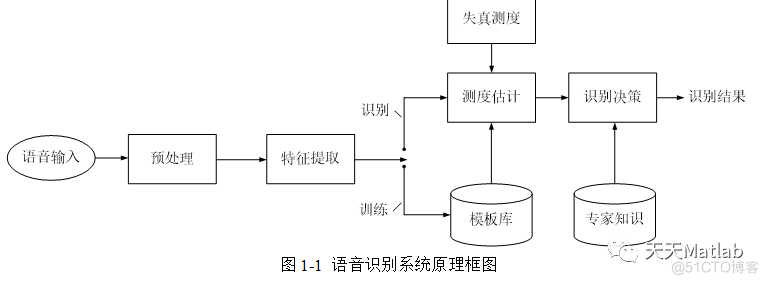1 简介 在孤立词语音识别中,动态时间规整DTW算法是一种应用较为广泛的算法之一,有着较强的科学性,在立足于当前DTW语音识别算法应用的实际情况下,简略阐述了该课题的研究背景,并从
1 简介
在孤立词语音识别中,动态时间规整DTW算法是一种应用较为广泛的算法之一,有着较强的科学性,在立足于当前DTW语音识别算法应用的实际情况下,简略阐述了该课题的研究背景,并从预处理和特征参数提取以及DTW算法两方面着手对基于DTW算法的语音识别系统实现进行了探究,以此为基础展开了相应的仿真和分析,旨在为相关研究人员提供参考.
语音识别系统的典型原理框图如图1-1所示。从图中可以看出语音识别系统的本质就是一种模式识别系统,它也包括特征提取、模式匹配、参考模式库等基本单元。由于语音信号是一种典型的非平稳信号,加之呼吸气流、外部噪音、电流干扰等使得语音信号不能直接用于提取特征,而要进行前期的预处理。预处理过程包括预滤波、采样和量化、分帧、加窗、预加重、端点检测等。经过预处理的语音数据就可以进行特征参数提取。在训练阶段,将特征参数进行一定的处理之后,为每个词条得到一个模型,保存为模板库。在识别阶段,语音信号经过相同的通道得到语音参数,生成测试模板,与参考模板进行匹配,将匹配分数最高的参考模板作为识别结果。后续的处理过程还可能包括更高层次的词法、句法和文法处理等,从而最终将输入的语音信号转变成文本或命令。

本文所描述的语音识别系统(下称本系统)将对数字0~9共10段参考语音进行训练并建立模板库,之后将对多段测试语音进行识别测试。系统实现了上图中的语音输入、预处理、特征提取、训练建立模板库和识别等模块,最终建立了一个比较完整的语音识别系统。
2 部分代码
function [x,mn,mx]=melbankm(p,n,fs,fl,fh,w)%MELBANKM determine matrix for a mel-spaced filterbank [X,MN,MX]=(P,N,FS,FL,FH,W)
%
% Inputs: p number of filters in filterbank
% n length of fft
% fs sample rate in Hz
% fl low end of the lowest filter as a fraction of fs (default = 0)
% fh high end of highest filter as a fraction of fs (default = 0.5)
% w any sensible combination of the following:
% 't' triangular shaped filters in mel domain (default)
% 'n' hanning shaped filters in mel domain
% 'm' hamming shaped filters in mel domain
%
% 'z' highest and lowest filters taper down to zero (default)
% 'y' lowest filter remains at 1 down to 0 frequency and
% highest filter remains at 1 up to nyquist freqency
%
% If 'ty' or 'ny' is specified, the total power in the fft is preserved.
%
% Outputs: x a sparse matrix containing the filterbank amplitudes
% If x is the only output argument then size(x)=[p,1+floor(n/2)]
% otherwise size(x)=[p,mx-mn+1]
% mn the lowest fft bin with a non-zero coefficient
% mx the highest fft bin with a non-zero coefficient
%
% Usage: f=fft(s); f=fft(s);
% x=melbankm(p,n,fs); [x,na,nb]=melbankm(p,n,fs);
% n2=1+floor(n/2); z=log(x*(f(na:nb)).*conj(f(na:nb)));
% z=log(x*abs(f(1:n2)).^2);
% c=dct(z); c(1)=[];
%
% To plot filterbanks e.g. plot(melbankm(20,256,8000)')
%
%
%%%%%%%%%%%%%%%%%%%%%%%%%%%%%%%%%%%%%%%%%%%%%%%%%%%%%%%%%%%%%%%%%%%%%%%%%%%%%%%%%
% This program is free software; you can redistribute it and/or modify
% it under the terms of the GNU General Public License as published by
% the Free Software Foundation; either version 2 of the License, or
% (at your option) any later version.
%
% This program is distributed in the hope that it will be useful,
% but WITHOUT ANY WARRANTY; without even the implied warranty of
% MERCHANTABILITY or FITNESS FOR A PARTICULAR PURPOSE. See the
% GNU General Public License for more details.
%
% You can obtain a copy of the GNU General Public License from
% ftp://prep.ai.mit.edu/pub/gnu/COPYING-2.0 or by writing to
% Free Software Foundation, Inc.,675 Mass Ave, Cambridge, MA 02139, USA.
%%%%%%%%%%%%%%%%%%%%%%%%%%%%%%%%%%%%%%%%%%%%%%%%%%%%%%%%%%%%%%%%%%%%%%%%%%%%%%%%%
if nargin < 6
w='tz';
if nargin < 5
fh=0.5;
if nargin < 4
fl=0;
end
end
end
f0=700/fs;
fn2=floor(n/2);
lr=log((f0+fh)/(f0+fl))/(p+1);
% convert to fft bin numbers with 0 for DC term
bl=n*((f0+fl)*exp([0 1 p p+1]*lr)-f0);
b2=ceil(bl(2));
b3=floor(bl(3));
if any(w=='y')
pf=log((f0+(b2:b3)/n)/(f0+fl))/lr;
fp=floor(pf);
r=[ones(1,b2) fp fp+1 p*ones(1,fn2-b3)];
c=[1:b3+1 b2+1:fn2+1];
v=2*[0.5 ones(1,b2-1) 1-pf+fp pf-fp ones(1,fn2-b3-1) 0.5];
mn=1;
mx=fn2+1;
else
b1=floor(bl(1))+1;
b4=min(fn2,ceil(bl(4)))-1;
pf=log((f0+(b1:b4)/n)/(f0+fl))/lr;
fp=floor(pf);
pm=pf-fp;
k2=b2-b1+1;
k3=b3-b1+1;
k4=b4-b1+1;
r=[fp(k2:k4) 1+fp(1:k3)];
c=[k2:k4 1:k3];
v=2*[1-pm(k2:k4) pm(1:k3)];
mn=b1+1;
mx=b4+1;
end
if any(w=='n')
v=1-cos(v*pi/2);
elseif any(w=='m')
v=1-0.92/1.08*cos(v*pi/2);
end
if nargout > 1
x=sparse(r,c,v);
else
x=sparse(r,c+mn-1,v,p,1+fn2);
end
3 仿真结果

4 参考文献
[1]吴晓平, 崔光照, 路康. 基于DTW算法的语音识别系统实现[J]. 信息化研究, 2004(07):17-19.
博主简介:擅长智能优化算法、神经网络预测、信号处理、元胞自动机、图像处理、路径规划、无人机等多种领域的Matlab仿真,相关matlab代码问题可私信交流。
部分理论引用网络文献,若有侵权联系博主删除。

